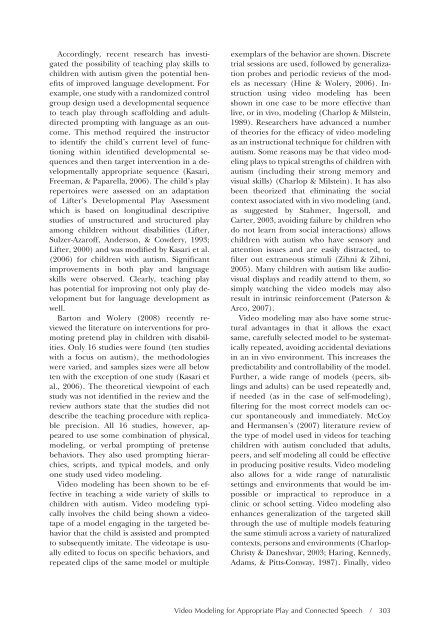etadd_47(3) - Division on Autism and Developmental Disabilities
etadd_47(3) - Division on Autism and Developmental Disabilities
etadd_47(3) - Division on Autism and Developmental Disabilities
You also want an ePaper? Increase the reach of your titles
YUMPU automatically turns print PDFs into web optimized ePapers that Google loves.
Accordingly, recent research has investigated<br />
the possibility of teaching play skills to<br />
children with autism given the potential benefits<br />
of improved language development. For<br />
example, <strong>on</strong>e study with a r<strong>and</strong>omized c<strong>on</strong>trol<br />
group design used a developmental sequence<br />
to teach play through scaffolding <strong>and</strong> adultdirected<br />
prompting with language as an outcome.<br />
This method required the instructor<br />
to identify the child’s current level of functi<strong>on</strong>ing<br />
within identified developmental sequences<br />
<strong>and</strong> then target interventi<strong>on</strong> in a developmentally<br />
appropriate sequence (Kasari,<br />
Freeman, & Paparella, 2006). The child’s play<br />
repertoires were assessed <strong>on</strong> an adaptati<strong>on</strong><br />
of Lifter’s <strong>Developmental</strong> Play Assessment<br />
which is based <strong>on</strong> l<strong>on</strong>gitudinal descriptive<br />
studies of unstructured <strong>and</strong> structured play<br />
am<strong>on</strong>g children without disabilities (Lifter,<br />
Sulzer-Azaroff, Anders<strong>on</strong>, & Cowdery, 1993;<br />
Lifter, 2000) <strong>and</strong> was modified by Kasari et al.<br />
(2006) for children with autism. Significant<br />
improvements in both play <strong>and</strong> language<br />
skills were observed. Clearly, teaching play<br />
has potential for improving not <strong>on</strong>ly play development<br />
but for language development as<br />
well.<br />
Bart<strong>on</strong> <strong>and</strong> Wolery (2008) recently reviewed<br />
the literature <strong>on</strong> interventi<strong>on</strong>s for promoting<br />
pretend play in children with disabilities.<br />
Only 16 studies were found (ten studies<br />
with a focus <strong>on</strong> autism), the methodologies<br />
were varied, <strong>and</strong> samples sizes were all below<br />
ten with the excepti<strong>on</strong> of <strong>on</strong>e study (Kasari et<br />
al., 2006). The theoretical viewpoint of each<br />
study was not identified in the review <strong>and</strong> the<br />
review authors state that the studies did not<br />
describe the teaching procedure with replicable<br />
precisi<strong>on</strong>. All 16 studies, however, appeared<br />
to use some combinati<strong>on</strong> of physical,<br />
modeling, or verbal prompting of pretense<br />
behaviors. They also used prompting hierarchies,<br />
scripts, <strong>and</strong> typical models, <strong>and</strong> <strong>on</strong>ly<br />
<strong>on</strong>e study used video modeling.<br />
Video modeling has been shown to be effective<br />
in teaching a wide variety of skills to<br />
children with autism. Video modeling typically<br />
involves the child being shown a videotape<br />
of a model engaging in the targeted behavior<br />
that the child is assisted <strong>and</strong> prompted<br />
to subsequently imitate. The videotape is usually<br />
edited to focus <strong>on</strong> specific behaviors, <strong>and</strong><br />
repeated clips of the same model or multiple<br />
exemplars of the behavior are shown. Discrete<br />
trial sessi<strong>on</strong>s are used, followed by generalizati<strong>on</strong><br />
probes <strong>and</strong> periodic reviews of the models<br />
as necessary (Hine & Wolery, 2006). Instructi<strong>on</strong><br />
using video modeling has been<br />
shown in <strong>on</strong>e case to be more effective than<br />
live, or in vivo, modeling (Charlop & Milstein,<br />
1989). Researchers have advanced a number<br />
of theories for the efficacy of video modeling<br />
as an instructi<strong>on</strong>al technique for children with<br />
autism. Some reas<strong>on</strong>s may be that video modeling<br />
plays to typical strengths of children with<br />
autism (including their str<strong>on</strong>g memory <strong>and</strong><br />
visual skills) (Charlop & Milstein). It has also<br />
been theorized that eliminating the social<br />
c<strong>on</strong>text associated with in vivo modeling (<strong>and</strong>,<br />
as suggested by Stahmer, Ingersoll, <strong>and</strong><br />
Carter, 2003, avoiding failure by children who<br />
do not learn from social interacti<strong>on</strong>s) allows<br />
children with autism who have sensory <strong>and</strong><br />
attenti<strong>on</strong> issues <strong>and</strong> are easily distracted, to<br />
filter out extraneous stimuli (Zihni & Zihni,<br />
2005). Many children with autism like audiovisual<br />
displays <strong>and</strong> readily attend to them, so<br />
simply watching the video models may also<br />
result in intrinsic reinforcement (Paters<strong>on</strong> &<br />
Arco, 2007).<br />
Video modeling may also have some structural<br />
advantages in that it allows the exact<br />
same, carefully selected model to be systematically<br />
repeated, avoiding accidental deviati<strong>on</strong>s<br />
in an in vivo envir<strong>on</strong>ment. This increases the<br />
predictability <strong>and</strong> c<strong>on</strong>trollability of the model.<br />
Further, a wide range of models (peers, siblings<br />
<strong>and</strong> adults) can be used repeatedly <strong>and</strong>,<br />
if needed (as in the case of self-modeling),<br />
filtering for the most correct models can occur<br />
sp<strong>on</strong>taneously <strong>and</strong> immediately. McCoy<br />
<strong>and</strong> Hermansen’s (2007) literature review of<br />
the type of model used in videos for teaching<br />
children with autism c<strong>on</strong>cluded that adults,<br />
peers, <strong>and</strong> self modeling all could be effective<br />
in producing positive results. Video modeling<br />
also allows for a wide range of naturalistic<br />
settings <strong>and</strong> envir<strong>on</strong>ments that would be impossible<br />
or impractical to reproduce in a<br />
clinic or school setting. Video modeling also<br />
enhances generalizati<strong>on</strong> of the targeted skill<br />
through the use of multiple models featuring<br />
the same stimuli across a variety of naturalized<br />
c<strong>on</strong>texts, pers<strong>on</strong>s <strong>and</strong> envir<strong>on</strong>ments (Charlop-<br />
Christy & Daneshvar, 2003; Haring, Kennedy,<br />
Adams, & Pitts-C<strong>on</strong>way, 1987). Finally, video<br />
Video Modeling for Appropriate Play <strong>and</strong> C<strong>on</strong>nected Speech / 303

















